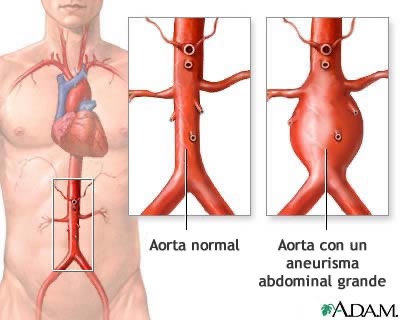Talk to Your Doctor About Abdominal Aortic Aneurysm
If you’re a man age 65 to 75 and have ever smoked, ask your doctor about getting screened (tested) for abdominal aortic aneurysm (AAA).
What is AAA?
The aorta is your body’s main artery. An artery is a blood vessel (or tube) that carries blood from your heart. The aorta carries blood from your heart to your abdomen, pelvis, and legs.
If the wall of your aorta is weak, it can start to bulge. This balloon-like bulge is called an aneurysm. AAA is an aneurysm that happens in the part of the aorta running through the abdomen.
Am I at risk for AAA?
Men over age 65 who have smoked at any point in their lives have the highest risk of AAA. Both men and women can have AAA, but it’s more common in men.
Risk factors for AAA include:
- Smoking, both if you smoke now or you smoked in the past
- Family history — for example, if a parent or sibling had AAA
- Older age, especially age 65 years or older
- Being white
- Having other aneurysms, like thoracic aortic aneurysm (similar to AAA but in the chest instead of the abdomen)
- High blood pressure or high cholesterol
- Heart disease or vascular disease (problems with blood vessels)
Why do I need to talk to the doctor?
Aneurysms usually grow slowly without any symptoms. When aneurysms grow large enough to rupture (burst), they can cause dangerous bleeding inside the body that can lead to death. The aneurysm can also create a tear in the wall, which is a serious problem, too.
If AAA is found early, it can be treated before it bursts. That’s why it’s so important to talk to your doctor about your risk.
Testing and Symptoms
How do I know if I have AAA?
To screen for AAA, your doctor may order an ultrasound. An ultrasound uses sound waves to look inside the body. It can help your doctor see if there’s any swelling in your aorta. Ultrasounds can be a little bit uncomfortable, but they don’t usually cause pain.
What are the symptoms of AAA?
AAA doesn’t usually cause symptoms until it’s a medical emergency. Blood vessels like the aorta can bulge out slowly over time, so it’s important to talk with your doctor about AAA to see if you need to get tested.
Although people with an AAA may not have any symptoms, some people may notice:
- Back pain
- A pulse you can feel near or below your belly button
- Dull ache or pain in the belly or side of your belly
- Discolored skin or sores on feet and toes (this is rare)
When a AAA ruptures or starts to leak blood, it’s a medical emergency since blood loss from the aorta can lead to death. Some symptoms of a ruptured abdominal aortic aneurysm include:
- Sudden pain in your lower back, abdomen, or legs — usually the pain is severe
- Fast heart rate
- Low blood pressure
- Nausea (feeling like you’re going to throw up) and vomiting (throwing up)
- Clammy (sweaty) skin
If you think you have a ruptured aneurysm, call 911 or have someone take you to the closest emergency room. You’ll need to have life-saving surgery right away.
What does AAA look like?
Here’s an example of what AAA looks like inside the body:



